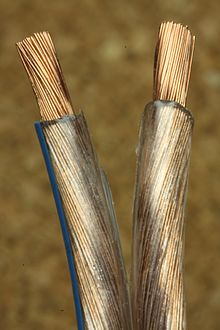Electrical conductor
This article does not have any sources. (April 2021) |
A conductor is a material which allows electricity, heat or sound to flow through it.

An electrical conductor conducts electricity. The ability to conduct electricity is called electrical conductivity. An excellent electrical conductor has high conductivity and low resistivity. Electrical resistivity is the reciprocal/opposite of conductivity.
Prominent electrical conductors include:
- Copper
- Aluminum
- Gold
- Silver
- Water
- Human skin
Metals, like iron and copper, are used to make wires to carry electric current. Plasma is an excellent conductor of electricity and is used for many purposes but metals are more used.
Impure water can also conduct electricity. Living tissues, as in the human body, are wet and therefore conductors of electricity.
Some materials are semiconductors. This means that electricity can flow through them to a certain temperature and below that semiconductors [1]do not pass electricity.
Some materials are resistors. This means electricity does not easily flow through them.
A material that stops electric current is called an insulator (electricity). Wires are covered with insulators like plastic to stop the electricity from leaving the wire.
Some materials when very cold, are superconductors. They offer no resistance at all to the flow of electricity.
Most conductors' resistance becomes higher at higher temperatures.
References
change- ↑ "What is a semiconductor? - Types, Advantages, Applications and more". 25 May 2021. Archived from the original on 2022-12-08. Retrieved 2021-09-30.